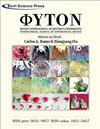Overexpression of β-1,4-Glucanase Gene EuEG1 Improves Micrografting of Eucommia ulmoides
IF 1.3
4区 生物学
Q3 PLANT SCIENCES
Phyton-international Journal of Experimental Botany
Pub Date : 2023-01-01
DOI:10.32604/phyton.2023.043803
引用次数: 0
Abstract
Adventitious root formation poses a major constraint on the tissue culture and genetic transformation of Eucommia ulmoides. Micrografting offers a new method for the transplantation of genetic transformation, and its success depends on the formation of graft unions. This study used transgenic rootless test-tube seedlings as scions and seedlings from seed as rootstocks during micrografting to avoid the rooting issues that occur during tissue culture and to investigate the role of the EuEG1 gene in the graft healing process. We found that the EuEG1 gene is a vital regulator of graft, and its overexpression contributes to the survival of Eucommia ulmoides micrografting. The EuEG1 gene transgenic plants (TP) used as scions for micrografting presented a significantly higher survival rate than the wild type (WT) and empty vector (EV) regenerated scions. During the grafting healing process, the expression of the EuEG1 gene was higher during the period of callus proliferation, suggesting that the EuEG1 gene was involved in the graft healing process. Histological observation revealed that more calluses tissue appeared at the junction of transgenic scions, and the connection with the rootstock was stronger, which benefits wound healing. These results provide new insights into Eucommia ulmoides micrografting and indicate that the EuEG1 gene can promote wound healing and improve the micrografting survival rate.β-1,4-葡聚糖酶基因EuEG1的过表达促进杜仲的微嫁接
不定根的形成是制约杜仲组织培养和遗传转化的主要因素。微移植为遗传转化移植提供了一种新的方法,其成功与否取决于移植物结合的形成。为了避免组织培养过程中出现的生根问题,本研究采用转基因无根试管苗作为接穗,种子苗作为砧木进行微嫁接,并探讨EuEG1基因在移植物愈合过程中的作用。我们发现EuEG1基因是嫁接的重要调控因子,其过表达有助于杜仲显微嫁接的存活。用EuEG1基因转基因植株(TP)作为接穗进行微嫁接,其成活率显著高于野生型(WT)和空载体(EV)再生接穗。在嫁接愈合过程中,愈伤组织增殖期EuEG1基因表达量较高,说明EuEG1基因参与了嫁接愈合过程。组织学观察表明,转基因接穗的接穗处出现了较多的愈伤组织,且与砧木的连接更强,有利于创面愈合。这些结果为杜仲显微移植提供了新的思路,说明EuEG1基因能够促进创面愈合,提高显微移植成活率。
本文章由计算机程序翻译,如有差异,请以英文原文为准。
求助全文
约1分钟内获得全文
求助全文
来源期刊
CiteScore
1.90
自引率
11.80%
发文量
17
审稿时长
12 months
期刊介绍:
Phyton-International Journal of Experimental Botany is an international journal that publishes on the broadest aspects of plant biology and ecology. The journal welcomes the original and exciting submissions that provide new and fundamental insights into the origins, development, and function of plants from the molecular to the whole organism and its interactions within the biotic and abiotic environment. Phyton-International Journal of Experimental Botany publishes outstanding research in the plant and ecology sciences, especially in the areas of plant physiology and biochemistry, plant metabolism, plant ecology and evolution, as well as those making use of synthetic, modeling, bioinformatics, and -omics tools. Manuscripts submitted to this journal must not be under simultaneous consideration or have been published elsewhere, either in part or in whole.

 求助内容:
求助内容: 应助结果提醒方式:
应助结果提醒方式:


